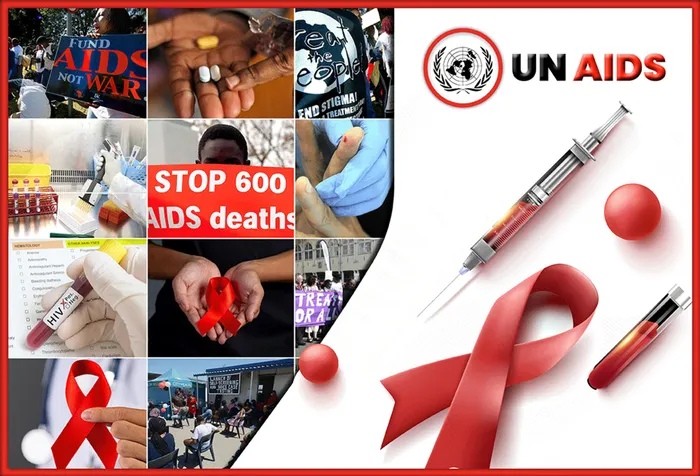Global crises spur spike in new HIV cases

Graphic: Timothy Alexander/African News Agency (ANA)
By Kelly-Jane Turner
A compounding number of crises in recent years have slowed the global fight against HIV and threaten to derail the goal set by world leaders to end AIDS by 2030.
This according to a recent report by the Joint United Nations Programme on HIV and Aids (UNAids).
Launched during the International Aids Conference that took place in Montreal, Canada last week, the report found that faltering progress meant that approximately 1.5 million new HIV infections occurred in 2021.
UNAids executive director Winnie Byanyima, said the Covid-19 pandemic led to disruptions to key HIV treatment and prevention services, a spike in teenage pregnancies and gender-based violence.
“Over the last two years, the multiple and overlapping crises that have rocked the world have had a devastating impact on people living with and affected by HIV, and they have knocked back the global response to the Aids pandemic,” she said.
In 2021, global resources dedicated to HIV care were 6 percent less than in 2010, according to the UNAids report.
Other crises such as the war in Ukraine and the global food price spike pose significant risks to the availability and affordability of HIV treatment medication.
HIV treatment (antiretroviral therapy or ART) requires a daily dose and when administered regularly, can significantly reduce an individual's ability to transmit the virus.
However, when the treatment programme is disturbed, resistance to the medication can develop.
“These data show the global Aids response in severe danger. If we are not making rapid progress, then we are losing ground, as the pandemic thrives amidst Covid-19, mass displacement, and other crises,” Byanyima said.
HIV continues to be a major global public health issue and has claimed and estimated 40.1 million lives so far.
HIV on the African continent
The UNAids report found that girls and young women in sub-Saharan Africa are three times more likely to acquire HIV than adolescent boys and young men.
The Global Aids Report titled “In Danger” warned that new infections have disproportionately affected certain groups.
Most notably young women and adolescent girls accounted for nearly half of all new infections worldwide last year. The report noted that other groups like gay men, sex workers and people who inject drugs also face increasing risk.
The number of new global HIV infections between 2020 and 2021 fell by only 3.6 percent, which is the smallest decline since 2016.
Around 1.5 million people were newly infected with HIV in 2021, a figure which the UN says represents over 1 million more than health authorities had targeted for that year.
In South Africa, Stats SA revealed in the 2022 mid-year population estimates report that around 8.45 million people are living with HIV.
Twenty years ago, the estimated number was 3.68 million people.
The report, which was released last week Thursday said the country’s population is estimated to be 60.6 million.
Stats SA said the Covid-19 pandemic has, to some extent, interrupted South Africa's HIV prevention and treatment programmes.
Meanwhile, the United States President’s Emergency Plan for Aids Relief (PEPFAR) has committed to continue supporting South Africa in the fight against HIV infections, especially new infections amongst young people.
PEPFAR ambassador-at-large and co-ordinator of the US Government Activities to Combat HIV/Aids Globally, Dr John Nkengasong, and minister of Health Dr Joe Phaahla made this commitment during the International Aids Conference in Montreal.
Strong commitments for 2030
By the end of the decade, global health partners are aiming to end Aids in children and ensure that no child living with HIV is denied treatment.
UNAids, Unicef and the World Health Organisation (WHO) together have formed the new Global Alliance for Ending Aids in Children by 2030.
Relying on statistics from the UNAids report, the alliance has revealed that globally, only half of children living with HIV are on life-saving treatment.
This is in stark contrast to adults where three quarters are receiving antiretrovirals.
WHO Director-General Dr Tedros Adhanom Gheberyesus has said that no child should go without treatment.
“The fact that only half of children with HIV receive antiretrovirals is a scandal, and a stain on our collective conscience. The Global Alliance to End Aids in Children is an opportunity to renew our commitment to children and their families to unite, to speak and to act with purpose and in solidarity with all mothers, children and adolescents.”
Twelve countries have joined the alliance so far, and they include Angola, Cameroon, Côte d'Ivoire, The Democratic Republic of the Congo (DRC), Kenya, Mozambique, Nigeria, South Africa, Tanzania, Uganda, Zambia, and Zimbabwe.
Two patients “cured” of HIV
Scientists revealed at the Aids 2022 conference last week that two more HIV-positive patients have been "cured".
A man who has lived with HIV since the 1980s seems to have been cured of HIV after receiving a stem cell transplant for leukaemia.
The patient is known as the "City of Hope" patient after the US facility in Duarte, California, where he was treated.
The other “cured” case was a woman in Spain who has been essentially HIV-free for 15 years, after ending treatment with common HIV antiretroviral drugs.
Scientists believe the woman is part of an unusual group of people called "elite controllers" whose bodies naturally attack and suppress HIV, even eradicating it completely in some cases without drugs.
Kelly-Jane Turner is a multimedia journalist.
Facebook: Kelly-Jane Turner;
Twitter: @KellyJane_T
This article is original to the The African. To republish, see terms and conditions.